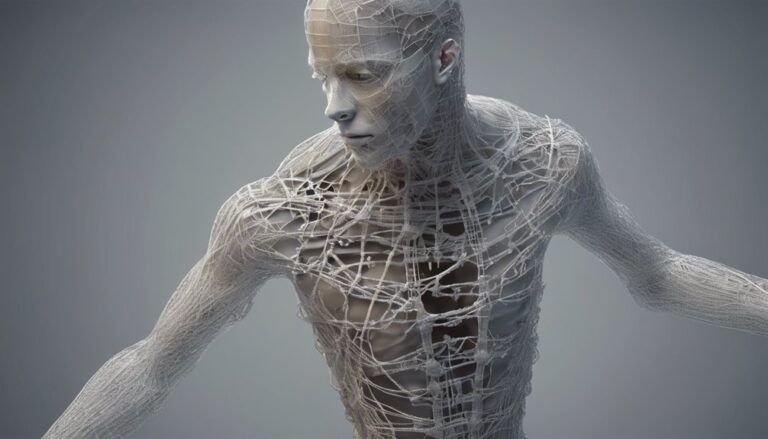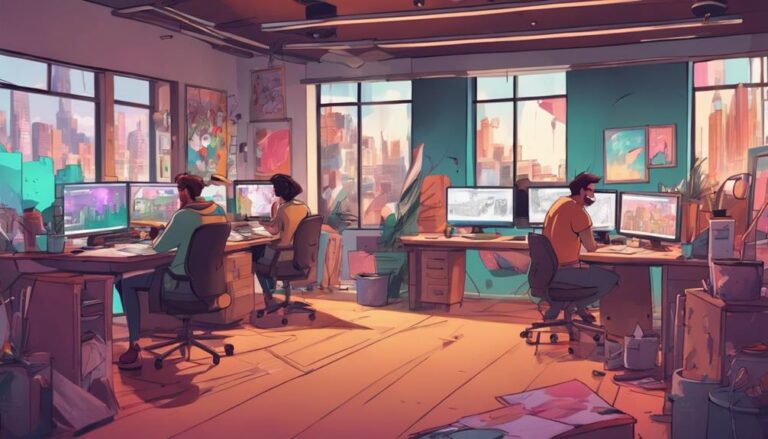7 Best Storyboarding Techniques for Animation Film Success
To boost your animation film's success, you'll want to master techniques like Thumbnail Storyboarding, where you sketch tiny, simple images to visualize key scenes and pace the story. Digital Storyboarding Software, such as Adobe Animate or Toon Boom Harmony, will streamline your workflow and enable collaboration. Techniques like The Beat Board and Animatic Storyboarding Process help you refine the narrative flow and pacing. Visual Storytelling Principles, like establishing a clear visual hierarchy, also play a crucial role. Collaborative methods, like team brainstorming and pitch development, ensure a clear and engaging story. By exploring these techniques, you'll unlock the full potential of storyboarding for your film.
Key Takeaways
- Thumbnail storyboarding helps visualize pacing and flow by sketching simple, key scenes in an animation.
- The beat board technique breaks down a story into key moments, emotional beats, and transitions for effective rhythm and flow.
- Animatic storyboarding refines shots and visualizes scene unfolding through the Block and Refine technique for clear goals and direction.
- Digital storyboarding software offers flexibility and efficiency, enabling faster iteration and collaboration in the storyboarding process.
- Streamlining workflow efficiency through task automation and workflow optimization saves time and energy in the storyboarding process.
Thumbnail Storyboarding Technique
With your pencil poised over a sheet of paper, you're ready to dive into the world of thumbnail storyboarding. This technique involves sketching out tiny images that represent key scenes in your animation.
Each thumbnail should be simple, yet convey the essence of the scene, focusing on composition, character placement, and action.
Thumbnail importance lies in its ability to help you visualize the overall pacing and flow of your story.
By quickly sketching out thumbnails, you can experiment with different shot sequences and make adjustments before investing time in more detailed drawings. This process saves you time and energy in the long run.
When creating thumbnails, consider the visual hierarchy of each scene.
What elements should be prominent, and what can be secondary? Use size, placement, and contrast to guide the viewer's eye through the scene.
By establishing a clear visual hierarchy, you'll create a more engaging and dynamic story.
Remember to keep your thumbnails small – about 1-2 inches square.
This will force you to focus on the essential elements and avoid unnecessary details.
Digital Storyboarding Software
You're now transitioning from traditional thumbnail storyboarding to the digital realm, where you'll weigh the pros and cons of switching from pencils and paper to digital tools like drawing tablets and software.
Traditional methods have their charm, but digital tools offer flexibility and efficiency.
As you explore digital storyboarding software, you'll want to consider top options and how they can streamline your workflow.
Traditional Vs Digital Tools
Diving into the world of digital storyboarding software can be a game-changer for animators.
You'll find that it offers a level of artistic freedom and creative expression that traditional methods can't match.
Gone are the days of erasing pencil marks and re-drawing panels – digital tools allow you to experiment and refine your ideas with ease.
As you weigh the pros and cons of traditional vs digital tools, consider the benefits of digital storyboarding:
- Faster iteration: Digital tools allow you to make changes quickly and easily, without having to re-draw entire panels.
- Collaboration: Digital storyboarding software makes it easy to share and collaborate on projects with others, regardless of location.
- Space-saving: Digital files take up virtually no space, making it easy to store and organize your work.
- Cost-effective: Digital tools can be more cost-effective than traditional methods, which require paper, pencils, and other supplies.
- Environmentally friendly: Digital storyboarding software reduces the need for paper and other materials, making it a more sustainable option.
With digital storyboarding software, you'll have the freedom to focus on your craft, rather than worrying about the logistics of traditional methods.
Top Software Options
Delving into the realm of digital storyboarding software, you'll find a multitude of innovative tools at your fingertips, each designed to unlock your full creative potential.
Industry standards such as Adobe Animate and TVPaint Animation offer robust features and seamless integration with other software, making them top software choices among animators.
Adobe Animate allows you to create complex storyboards and animations with its intuitive interface, and TVPaint Animation offers a more traditional hand-drawn feel with its extensive brush library.
Other notable software options include Toon Boom Harmony, a powerful tool for professional animators, and Blender, a free open-source software that offers a comprehensive 3D creation suite.
When choosing a digital storyboarding software, consider your specific needs and skill level.
Some software, like Storyboard Pro and FrameForge, cater to live-action filmmakers, while others, such as OpenToonz and Pencil2D, specialize in 2D animation.
By selecting the right software for your project, you'll be able to streamline your workflow and bring your vision to life.
Each software choice offers unique features and benefits, allowing you to find the perfect fit for your animation needs.
Streamlining Workflow Efficiency
Harmony in your workflow is key to unleashing your full creative potential in digital storyboarding.
As you dive deeper into the world of animation, you'll realize that task automation and workflow optimization are crucial in streamlining your workflow efficiency.
By implementing these techniques, you'll be able to focus on what truly matters – bringing your story to life.
To take your digital storyboarding to the next level, consider the following workflow optimization strategies:
- Automate tedious tasks: Use software features that allow you to automate repetitive tasks, such as formatting and layout adjustments.
- Customize your interface: Tailor your workspace to fit your needs, making it easier to access the tools you use most.
- Collaborate with ease: Implement real-time collaboration features that enable seamless communication with your team.
- Track changes and revisions: Use version control features to keep track of changes and revisions, ensuring that you're always working with the most up-to-date version.
- Set up a review process: Establish a clear review process to ensure that your work meets your high standards and is ready for the next stage of production.
The Beat Board Technique
| Beat Type | Description | Visual Representation |
|---|---|---|
| Key Moment | A critical event that drives the plot forward | A bold, eye-catching image |
| Emotional Beat | A moment that evokes a strong emotional response from the audience | A softer, more muted color palette |
| Transition | A moment that connects two key beats | A simple, flowing line or shape |
Animatic Storyboarding Process
As you transition into the animatic storyboarding process, you'll start by blocking and refining your shots, visualizing how each scene will unfold in your animation.
You'll then focus on timing and pacing, carefully crafting the rhythm and flow of your sequence to captivate your audience.
Block and Refine
When working on an animatic storyboarding process, you'll find the Block and Refine technique to be an essential step in bringing your animation to life.
This technique involves breaking down your animation into manageable chunks, allowing you to focus on the overall flow and pacing of your story.
In the Block stage, you'll create a rough, low-fidelity version of your animatic, focusing on the essential elements of each scene.
This stage helps you establish the overall structure of your story and identify potential issues early on.
As you move into the Refine stages, you'll add more detail and polish to your animatic, refining the timing and spacing of each element.
This stage is crucial in creating a cohesive and engaging visual narrative.
Key considerations for the Block and Refine technique:
- Establish clear goals for each scene to maintain focus and direction
- Use simple, gestural drawings to convey essential action and character movement
- Refine your animatic in passes, focusing on one element at a time (e.g., characters, backgrounds, special effects)
- Continuously review and revise your work to ensure it aligns with your overall vision
- Keep your animatic flexible, allowing for adjustments and changes as needed
Timing and Pacing
You've got a solid foundation laid with the Block and Refine technique, but now it's time to think about the rhythm of your animation.
This is where timing and pacing come into play. With an animatic, you're essentially creating a moving storyboard that helps you nail down the timing and pacing of each scene.
Think of it like a musical composition – the frame duration is equivalent to the beat, and the scene progression is like the melody.
By tweaking the frame duration, you can speed up or slow down the pacing of your scene. For example, if you want to create a sense of urgency, you might use shorter frame durations to make the scene feel more frenetic.
Conversely, longer frame durations can create a more contemplative atmosphere. Experiment with different frame durations to find the right rhythm for your scene.
As you work on your animatic, pay attention to how the scene progression flows. Make sure it's logical and engaging, with a clear beginning, middle, and end.
This will help you craft a narrative that draws your audience in and keeps them invested.
Visual Storytelling
In animatic storyboarding, something magical happens – static images begin to tell a story, and the narrative unfolds in a dynamic, visual language.
As you bring your storyboard to life, you're not just creating a sequence of images; you're crafting a visual hierarchy that guides the viewer's attention.
Every element, from character placement to background details, contributes to a cohesive visual language.
To effectively convey your story, consider the following visual storytelling techniques:
- Establish a clear visual hierarchy: Guide the viewer's attention through the use of size, color, and placement to create a clear focal point.
- Experiment with camera angles: Use a mix of wide shots, close-ups, and medium shots to create a dynamic visual flow.
- Use motion to convey emotion: Add movement to your storyboard to emphasize key moments and create a sense of tension or excitement.
- Play with lighting and shadows: Use lighting to create mood and atmosphere, and to draw attention to specific elements.
- Leave room for interpretation: Don't overexplain – leave some things to the viewer's imagination to create a more engaging experience.
Storyboard Pitch Development
As your animation project takes shape, developing a strong storyboarding pitch becomes crucial for selling your vision to clients, producers, or investors.
This is where pitch refinement comes in – distilling your story down to its core elements and presenting them in a clear, concise manner. You'll want to focus on story cohesion, ensuring that every scene and character serves a purpose in advancing the narrative.
To develop a solid pitch, start by identifying the key beats in your story.
Break it down into three acts, highlighting the main conflicts and turning points. Then, condense each act into a single sentence or image that captures its essence. This will help you distill the story to its most essential elements.
Next, create a verbal pitch that weaves these beats together into a compelling narrative.
Use descriptive language to paint a picture of your world and characters, and highlight the unique selling points of your project. Practice your pitch until it feels natural, and be prepared to adapt it to different audiences and time constraints.
Visual Storytelling Principles
Several key principles guide visual storytelling in animation, and mastering these fundamentals will help you craft a compelling narrative that engages your audience.
Visual emphasis is a crucial element in animation storytelling. By selectively focusing the viewer's attention on specific elements, you create a visual hierarchy that guides them through the story.
This emphasis can be achieved through various techniques, including composition, lighting, color, and movement.
To create a cohesive visual narrative, consider the following principles:
- Visual flow: Guide the viewer's eye through the scene using visual elements, such as lines, shapes, and movement.
- Emotional resonance: Use visual elements to evoke emotions and create a connection with the characters.
- Contrast: Use contrasting elements, such as light and dark, to create visual interest and emphasize key elements.
- Repetition: Repeat visual elements to create a sense of unity and cohesion throughout the story.
- Negative space: Use empty space effectively to create a sense of balance and visual harmony.
Collaborative Storyboarding Methods
Storyboarding is often a solitary process, but bringing collaborators on board can revolutionize the way you develop your animation.
When you involve others in your storyboarding process, you open yourself up to new ideas, perspectives, and expertise.
This is where team brainstorming sessions come in – a powerful tool for collaborative storytelling.
Gather your team in a room, and start throwing ideas around.
Use sticky notes, whiteboards, or even just a large piece of paper to capture every concept that comes up.
This free-flowing process helps you generate a wealth of ideas and builds on the creativity of each team member.
Collaborative meetings can then be used to refine these ideas and turn them into a cohesive narrative.
These meetings should be structured, with a clear agenda and goals for the discussion.
This is where you can start to visualize the story as a whole, identifying key scenes, pacing, and character development.
By working together, you can identify potential problems and come up with innovative solutions that you mightn't have thought of on your own.
This collaborative approach can lead to a more engaging, well-rounded story that resonates with your audience.
Frequently Asked Questions
Can Storyboarding Be Used for Live-Action Film Production?
You can definitely use storyboarding in live-action film production. It helps you break down the script, create a visual blueprint, and plan shots before filming, saving time and resources in the long run.
How Long Does It Take to Create a Storyboard?
You're working on a project's visual blueprint, and you're wondering how long it'll take. The storyboard timeline can vary, but generally, it takes around 1-3 weeks to create a rough draft, factoring in creative pacing and revisions.
What Skills Are Required for a Storyboarding Job?
You'll need a mix of artistic and technical skills, including drawing, visual storytelling, and attention to detail, to bring a creative vision to life and convey it effectively through visual elements and sequential art.
Can I Use My Smartphone for Storyboarding Purposes?
You can use your smartphone for storyboarding by leveraging mobile apps like FrameForge or Storyboard Pro. Experiment with camera angles and shots to visualize your sequence, then capture and edit frames with your phone's camera.
Is Storyboarding Essential for Short Animation Films?
When creating short animation films, you realize that storyboarding isn't just beneficial, it's crucial for visual planning. It's your blueprint, offering creative freedom to experiment and refine your vision before diving into production.
Conclusion
You've explored the best storyboarding techniques for animation film success. With thumbnail sketches and digital software, you can refine your ideas. The beat board technique and animatic process help you visualize pacing and timing. Storyboard pitches sell your vision, while visual storytelling principles guide your creative decisions. By incorporating collaborative methods, you'll have a polished, engaging storyboard that brings your animation to life, captivating audiences worldwide with a seamless narrative flow.






